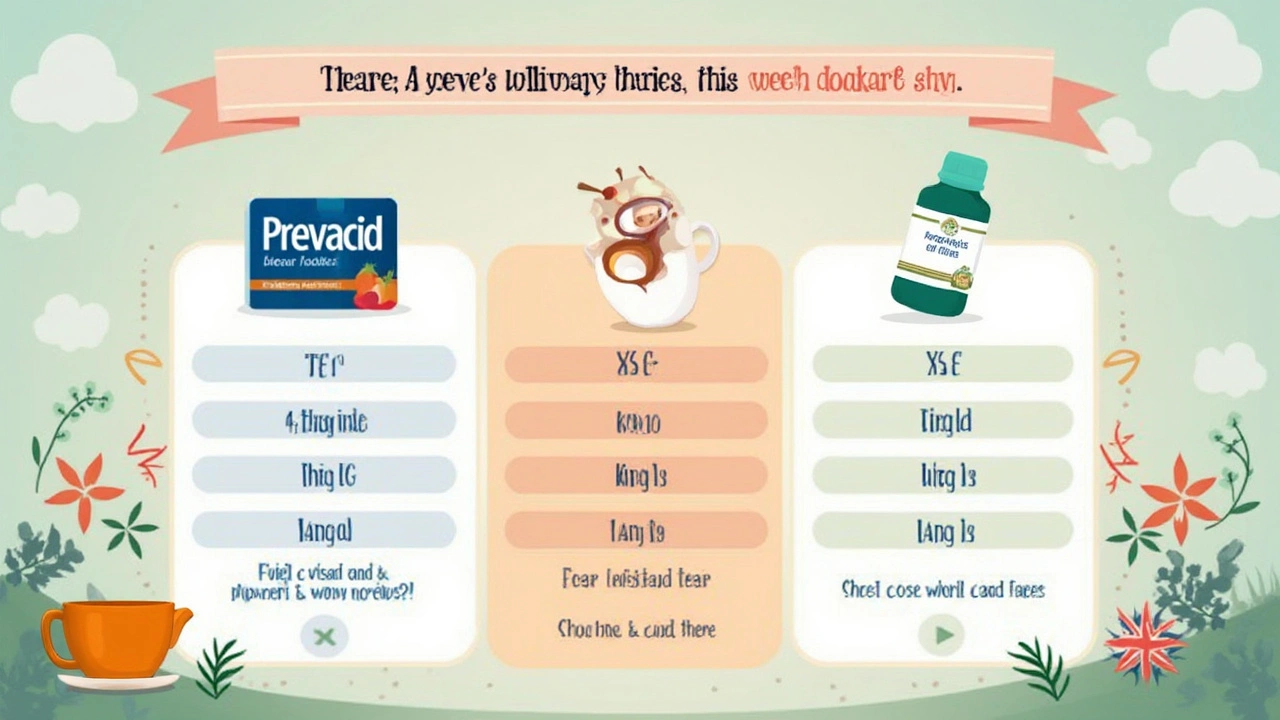Ever tried to sleep only to be jolted awake by burning pain in your chest? Night after night, that fiery dragon called heartburn can wear you down. For millions, this isn't just occasional discomfort—it's a daily battle. Walk into any pharmacy, and you’ll spot stacks of little pink-and-white boxes. Prevacid is one of the most recognized names in that lineup, promising to tame the flame inside your stomach. But does it work like magic? Is it safe for long-term use? Why do some folks swear by it while others end up frustrated? There's a mix of truth, myth, and wishful thinking out there when it comes to this acid reflux fighter. Here’s the real lowdown, packed with facts you wish your doctor had the time to explain.
What Exactly Is Prevacid and How Does It Work?
Prevacid, whose generic name is lansoprazole, is part of a larger class called proton pump inhibitors—or PPIs if you want to sound like a pharmacist. It doesn’t simply mask the problem for a couple of hours like antacids; it goes deeper. Prevacid actually blocks the stomach’s acid pumps, which sit in the walls of your stomach turning your lunch into a bubbling pool. By switching them off, Prevacid slashes acid production at the source. This is why it’s not just for quick relief, but for people with ongoing issues like gastroesophageal reflux disease (GERD), stomach ulcers, and even damage from long-term NSAID use.
Curious about how long it takes to work? Prevacid isn’t a sprinter—it's more of a marathon runner. Most people start to feel better after about one to four days of daily use. That means you can't just pop one pill for instant relief like you would a Tums. This slow build-up can feel frustrating if you’re in the thick of a heartburn attack, but it also means you’re setting up long-term defense, not just covering up symptoms. One interesting fact: a large study published in The American Journal of Gastroenterology found lansoprazole reduced heartburn symptoms by nearly 80% after eight weeks, compared to just 44% for the placebo group. That’s a leap, not a tiny step.
Let’s talk about the dosage. The standard prescription strength is 15mg or 30mg once daily, usually taken before breakfast. Over-the-counter Prevacid 24HR is set at 15mg. The catch? You need to stick to the daily schedule religiously. Skipping doses can throw off the whole acid control plan, so try setting a phone alarm or keeping the bottle next to your toothbrush.
Prevacid is clever but not always subtle; it can interact with other meds—sometimes in unexpected ways. For example, it can lower the absorption of drugs that rely on stomach acid, like ketoconazole or atazanavir, and might boost the blood-thinning power of warfarin. Grapefruit, that old nemesis of drug safety, isn’t a big player with Prevacid, but always double-check if your medicine list has any surprises. Even some supplements, like St. John’s Wort or certain calcium pills, can change the way Prevacid works. Always bring an up-to-date list of what you’re taking to your doctor or pharmacy so nothing gets missed.
About side effects—these are usually mild but worth knowing about. The classics are headache, diarrhea, nausea, and belly pain. But, now and then, more serious side effects crop up. Long-term users might see drops in magnesium or vitamin B12 levels (your doctor might check these with blood tests), and some research hints at a higher risk of bone fractures if used for years. Did you know, a study in England looked at nearly 200,000 adults on PPIs and found the fracture risk increased by about 30% if people were on them long-term? That doesn’t mean you’ll snap a bone tomorrow, but it’s worth thinking about for older folks or those already at risk.
Table: Common Side Effects and Risk Factors with Prevacid
| Side Effect | Chance (per 100 users) | More Likely If: |
|---|---|---|
| Headache | 10-13 | Sensitive to medications |
| Diarrhea | 3-5 | History of gut issues |
| B12 deficiency | 1-7 | Older age, vegan diet |
| Low magnesium | <1 | Chronic PPI users |
| Bone fracture | ~2 extra per 100 over 5 years | Postmenopausal women, elderly |
This stuff works, but it’s not cheat day for junk food. Coffee, hot sauce, fatty meals, and alcohol can still break through Prevacid’s defense line. Tweaking your eating routine, especially late at night, helps the medicine work better and cuts down on the risk of breakthrough symptoms.

Who Actually Needs Prevacid (and Who Might Be Better Off Without It)?
Straight talk: Doctors sometimes hand out proton pump inhibitors like candy. Yet, not every burn or burp means you need long-term acid suppression. The American College of Gastroenterology is clear: you should use Prevacid if you have frequent heartburn (two or more times a week), known ulcers in the stomach or intestine, or you’re taking meds that can damage your stomach lining, like strong painkillers or steroids. If acid keeps crawling up your throat at night or you wake with a sour taste and cough, you’re in the likely candidate zone.
But there are flipsides. Occasional heartburn, stress burps, or the aftermath of a spicy feast? These don’t always call for daily PPIs. Short bursts—say, 14 days with Prevacid 24HR—are generally safe, but using it daily “just in case” when you don’t need it sets you up for rebound acid when you quit. (Yep, stopping a PPI suddenly can make you feel worse before you feel better.) A 2023 survey in the US found that about 25% of long-term users could actually stop without their symptoms coming back, especially if they cleaned up their diet and sleeping habits.
What about kids or teens? Doctors are extra cautious with young ones. Most of the time, lifestyle tweaks get recommended first—raising the bed head, skipping sodas, checking allergies. But if your kid (like my son Ethan, who wrestled with reflux as a baby) has real damage from acid or keeps losing weight, a doctor might suggest a short course of *lansoprazole* under careful watch. Never start or end any acid blocker for a child without a pediatrician’s say-so, because their bodies process meds differently.
Ever hear about PPIs and dementia, kidney disease, or pneumonia? These headlines pop up in the news, sometimes stirring up more fear than facts. Most big studies show the risks are tiny for healthy adults using normal doses for months, not years. For those with complex health issues or who need acid blockers for years on end, doctors weigh these risks carefully. Not everyone agrees on where the “safe” cutoff is, but most experts say Prevacid is best for a few weeks to months unless you’ve got a proven medical reason for longer runs.
Fertility, pregnancy, and breastfeeding often raise big questions. Prevacid isn’t known to cause birth defects, and it’s sometimes used during pregnancy under medical advice. Usually, docs suggest trying antacids first, but if the burning won’t quit, a real prescription might be the kinder route. Breastfeeding moms are often switched to other PPIs with more data, but a quick chat with your doc clears this up fast.
In the end, if you’re not sure whether daily Prevacid is right for you, don’t be shy—ask your doctor or pharmacist. Bring your full med list, note how often symptoms show, and be honest about what you eat, drink, and do at night. The best plan isn’t a secret handshake; it’s tailored to you and your real-world habits.

Tips for Getting the Most From Prevacid (And How to Make Life Easier If You Have Heartburn)
You probably didn’t expect to learn that how and when you take Prevacid makes a world of difference. Here’s the real playbook, straight from gastro docs and people who’ve been there:
- Take it before breakfast: Your stomach wakes up ready to pump out acid with your first meal. Setting Prevacid to work just before you eat (usually 30-60 minutes ahead) helps it block the most acid during the day.
- Don’t chew or crush the capsule: It needs to hit your stomach whole. If you can’t swallow the pill, ask for the disintegrating tablet version—super handy for kids or adults with swallowing troubles.
- Avoid yo-yo dosing: Skipping days or doubling up if you forgot won’t help and can mess up the acid control. Pick a regular time slot and stick to it.
- Watch for trigger foods: Coffee, chocolate, peppermint, garlic, onions, tomatoes, and alcohol top the list for waking up reflux. Cutting back, especially on combos (like pizza and beer late at night), makes Prevacid more effective.
- Prop up at night: Use blocks, not just pillows, to tilt your head and chest above your stomach. Gravity is your friend when you’re trying to keep acid down while sleeping.
- Try smaller meals: Big plates put more pressure on your stomach, increasing the chance of backup. More, smaller meals = less acid splash.
- Check for interactions every time you add a new med or supplement. Your pharmacist can give quick answers about whether a new pill will play nice with Prevacid.
- If you forget a dose, take it when you remember unless it’s close to your next scheduled pill. Never take two at once to “catch up.”
- If symptoms come back hard after stopping, call your doctor. Rebound acid is real but usually gets better in a week or two. Short-term antacids or H2 blockers can get you through the rough patch.
One trick I picked up from several gastroenterologists: For people who only need acid control during the week (say, for work presentations or travel), you might try cycling the medicine—five days on, two days off. Just clear this with your doc, as it helps some but isn’t for everyone.
For the tech-minded, there are now medication reminder apps designed just for daily pills. These work especially well for parents managing medicine for kids who can’t remember themselves. You can set up refill reminders, symptom trackers, and even log flare-ups to share at doctor visits. It transforms the blur of symptoms into real data, which makes for faster solutions.
Ever worry about being judged for needing medicine? Acid reflux isn’t a character flaw. It’s stubborn, influenced by genetics, lifestyle, age, and sometimes just bad timing (ask anyone who gets it after a holiday meal). The same diet that barely affects your friend may leave you popping Prevacid for weeks. Be upfront with your healthcare team—they’re there to help, not judge.
If cost is an issue, generic lansoprazole is much cheaper than the brand name. Pharmacies run discounts, and some insurance plans cover it at the lowest tier. If you’re using over-the-counter Prevacid regularly, ask your doc about the prescription version—it can save a chunk of money every month, especially if you’re treating more than heartburn.
Can you stop Prevacid once you start? Most people can, especially if they adopt heartburn-friendly habits. Gradually easing off (every other day for a week, then stopping) sometimes helps prevent the rebound effect. That said, if you need it long-term to prevent real damage, stopping suddenly is a bad idea, so work with your doctor on a plan.
The bottom line: Prevacid works, but it works best when combined with smart life tweaks and honest conversations with your healthcare team. Whether you’re managing wild reflux or just trying to enjoy pizza without regret, knowing the ground rules puts you in charge, not your gut.






9 Comments
Lindy Swanson
June 14, 2025Honestly, I think most people treat Prevacid like a magic wand, but it's really just a band-aid for a lifestyle that’s out of whack. You can pop a pill and expect the fire to disappear instantly, yet the drug takes days to really kick in. Skipping doses because you “feel fine” just tells your stomach to go back to its old ways. If you rely on a PPI without cutting back on late-night pizza or endless coffee, you’re basically paying for a crutch that won’t last. And yeah, the bone fracture scare is real, but it’s mostly a concern for those who never think about calcium or exercise. Bottom line: Prevacid works, but only if you respect the schedule and the diet that comes with it.
Amit Kumar
June 23, 2025Hey folks, I just wanted to share how Prevacid totally changed my life 😄. I was constantly waking up with that burning feeling and I thought I was doomed to live with it forever. After reading the guide I decided to take the pill right before breakfast every single day 🌅. Within a week I noticed a huge drop in the morning flare‑ups and my coffee even tasted better ☕. I also started keeping a simple food journal to spot the triggers that were sneaking up on me 📓. Cutting back on late‑night spicy tacos made a world of difference and I could finally enjoy dinner without the dreaded after‑effects 🌮. My doctor checked my B12 levels after three months and everything was right on track, so I felt safe staying on the regimen 🩺. The best part? I stopped relying on antacids that gave me that chalky aftertaste 🙅♂️. I even set up a reminder app on my phone so I never missed a dose, and the little ping feels like a personal cheerleader 📱. My sister, who suffers from similar reflux, tried the same schedule and she’s now sleeping through the night without that sour taste 🌙. I also talked to my pharmacist about the possible drug interactions, and they assured me that my occasional vitamin D supplement was fine 👍. If you’re worried about cost, ask for the generic lansoprazole – it’s a fraction of the brand name price 💲. For anyone who thinks PPIs are a “quick fix”, remember they need patience, but the payoff is huge 🎉. I’ve even started a small support group at work where we swap recipes that are kind to the stomach 🍲. So yeah, Prevacid works wonders when you pair it with smart habits, and I’m living proof of that! 🎈
Crystal Heim
July 3, 2025Prevacid is a proton pump inhibitor It reduces acid production by blocking the H K ATPase enzyme in stomach lining It works best when taken consistently Not a miracle cure but a useful tool
Sruthi V Nair
July 12, 2025Life is about balance and the fire inside us mirrors the acid in our gut When we respect our bodies the flame softens The discipline of taking medicine on time becomes a meditation on self care It reminds us that small daily acts build larger health harmony
Mustapha Mustapha
July 21, 2025Friends, if you’re thinking about starting Prevacid, first check with your doctor about any existing conditions. Make sure you have a regular schedule – maybe pair it with a morning alarm so you don’t forget. Keep an eye on potential nutrient gaps; a simple B12 supplement can cover the occasional loss. Stay hydrated and try to eat smaller, balanced meals throughout the day. These small steps help the medication do its job without adding extra stress.
Ben Muncie
July 30, 2025Taking a prescription without a doctor’s advice is irresponsible.
kevin tarp
August 9, 2025While the point is clear, the sentence could benefit from proper capitalization and a period at the end. Also, “proton pump inhibitor” should be hyphenated as “proton‑pump inhibitor”. These tweaks improve readability and maintain professional tone.
ravi kumar
August 18, 2025In India we’ve been using herbal remedies for centuries, and many people think a Western drug like Prevacid is the only answer. That’s a mistake. Spices like turmeric and fennel actually help calm stomach acid, and our traditional meals are often balanced with yogurt that neutralizes excess HCl. While PPIs have their place, relying solely on them ignores the rich nutritional wisdom we have at home. If you combine a sensible diet with a doctor‑prescribed dose, you get the best of both worlds.
SandraAnn Clark
August 27, 2025Prevacid works but you still need to watch what you eat.